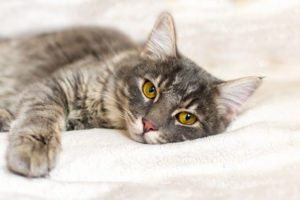Cats are incredibly adept at hiding their pain. In the wild, this is helpful to keep predators from knowing they’re vulnerable. Unfortunately for cat owners, this instinct makes it difficult to know when your cat is in pain in North Charleston, SC. Here are some signs to look out for.

Main Signs to Look out for
Listed below are the main signs of a cat in pain to look out for:
Lethargy
Considering the average housecat sleeps twelve to sixteen hours a day it may be hard to tell if they are laying around more than usual. If you notice your cat is less active during normal playtimes or not following you around as often, he may be in pain.
Hiding
Because cats hide their pain, they may hide from you. This isn’t because she is afraid of you, but rather because of her instinctual need to keep potential predators from thinking she’s weak.
Agitation
A cat in pain may struggle to get comfortable. You might notice him trembling or shifting around a lot before he is able to find a good position to lay or sit.
Excessive Grooming
Another instinct that animals have is to lick or chew at a sore spot. For instance, if your cat has pain in her right front paw you might see her grooming that paw excessively, sometimes to the point of further injury.
Bad Attitude
A painful cat can be a grumpy cat. If he is hurting, he may not let you or other pets get too close for fear of making the pain worse. Abnormal growling or hissing is a sure sign something is wrong with your kitty.
Accidents
A way some cats tell their humans that something is wrong is by going to the bathroom in inappropriate places. Abnormal urinating or defecating outside of her litter box is cause for concern and should be attended to by a veterinarian.
Lack of Appetite
Any change in eating habits should be noticed and addressed. Cats that are in pain tend to avoid food, particularly if that pain is in the digestive tract. If your pet has an injury, he might want to eat but lacks the will to journey to his bowl.
Limping
If you see a change in your cat’s gait, it is usually a sign of injury or soreness. She may be favoring one leg or refusing to use it at all.
Stiffness
All animals are susceptible to things like arthritis as they age. If your cat seems to be moving slower and stiffer than usual, particularly after being still for a long time, it may be the early signs of arthritis. Overweight cats or those that were overweight for a portion of their lives have a greater risk of developing arthritis.
Change in Breathing
If your furry friend is taking shorter, shallow breaths while awake, it is possible he is in pain. This could be an urgent matter and you should call your veterinarian immediately.
Weight Loss
Any unexplained weight loss is cause for concern. If you have more than one cat, it may be difficult to tell how much one of them is eating. Try separating all your feline friends during mealtime.
Muscle Loss
Some muscles loss is normal in an aging cat, but lack of mobility can cause the muscles to atrophy. If you are suddenly able to feel vertebra or hip bones when you normally couldn’t, she may be suffering in silence.
Squinting
Cats sometimes get eye infections or respiratory infections that cause discomfort. A cat in pain might close part of his nictating membrane, or third eyelid. You will notice him squinting and the lid on the inside of the corner of his eye will be visible.
Abnormal Vocalization
Cats that are in pain might call out. If the cat has a urinary issue or digestive problem, you might hear her cry when she is using the restroom. If there is an injury or painful spot of her body, touching that area might cause her to let out a meow, hiss or even growl to warn you that they are hurting.
Tail Flicking
Tail Flicking is a sign of agitation in cats. If your cat starts flicking his tail, particularly as someone approaches him, he is giving off a warning that he doesn’t want to be touched.
Avoiding Light
When people are sick, they tend to like to stay in a dark spot to rest. Cats are much the same and like to seek out a cave-like setting to recover in. Bright lights may be a source of agitation for a sick cat.
Lack of Grooming
Cats instinctively groom to keep their fur clean and free of pests. A cat that is in pain may do less grooming of herself. You might see her fur growing duller and more tangled if she is hurting.
Contact a Veterinarian in North Charleston, SC if Your Cat is in Pain
If you have noticed your cat displaying any of these signs, especially if you see more than one at a time, it is really important that you bring it to your veterinarian’s attention. While some diagnoses can be complicated to decipher, your vet will know the right steps to take to go about treating and healing your cat’s pain. For more information, contact Northwoods Veterinary Clinic by calling (843) 553-0441. Our team is dedicated to the life-long care of your pet.
